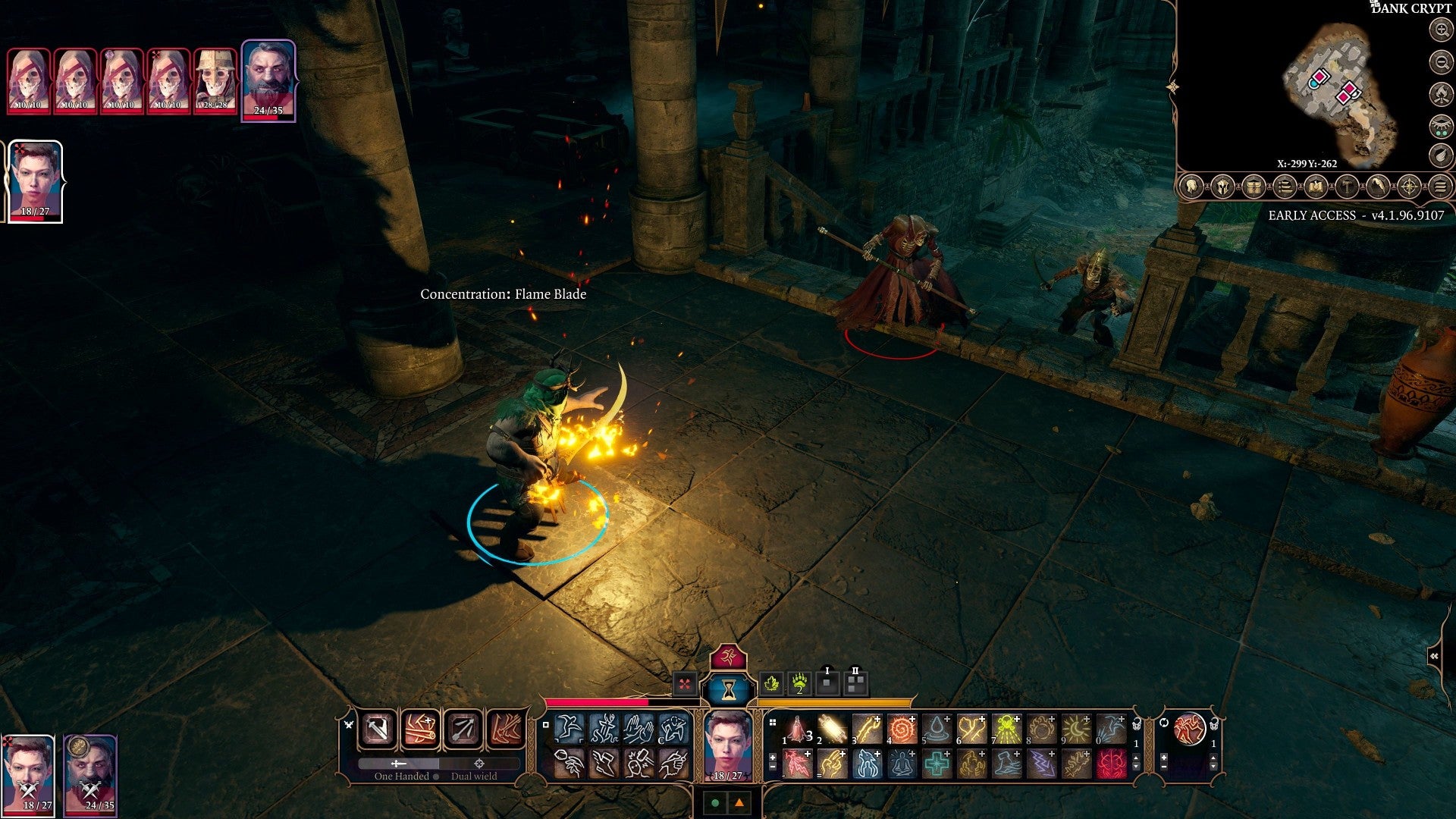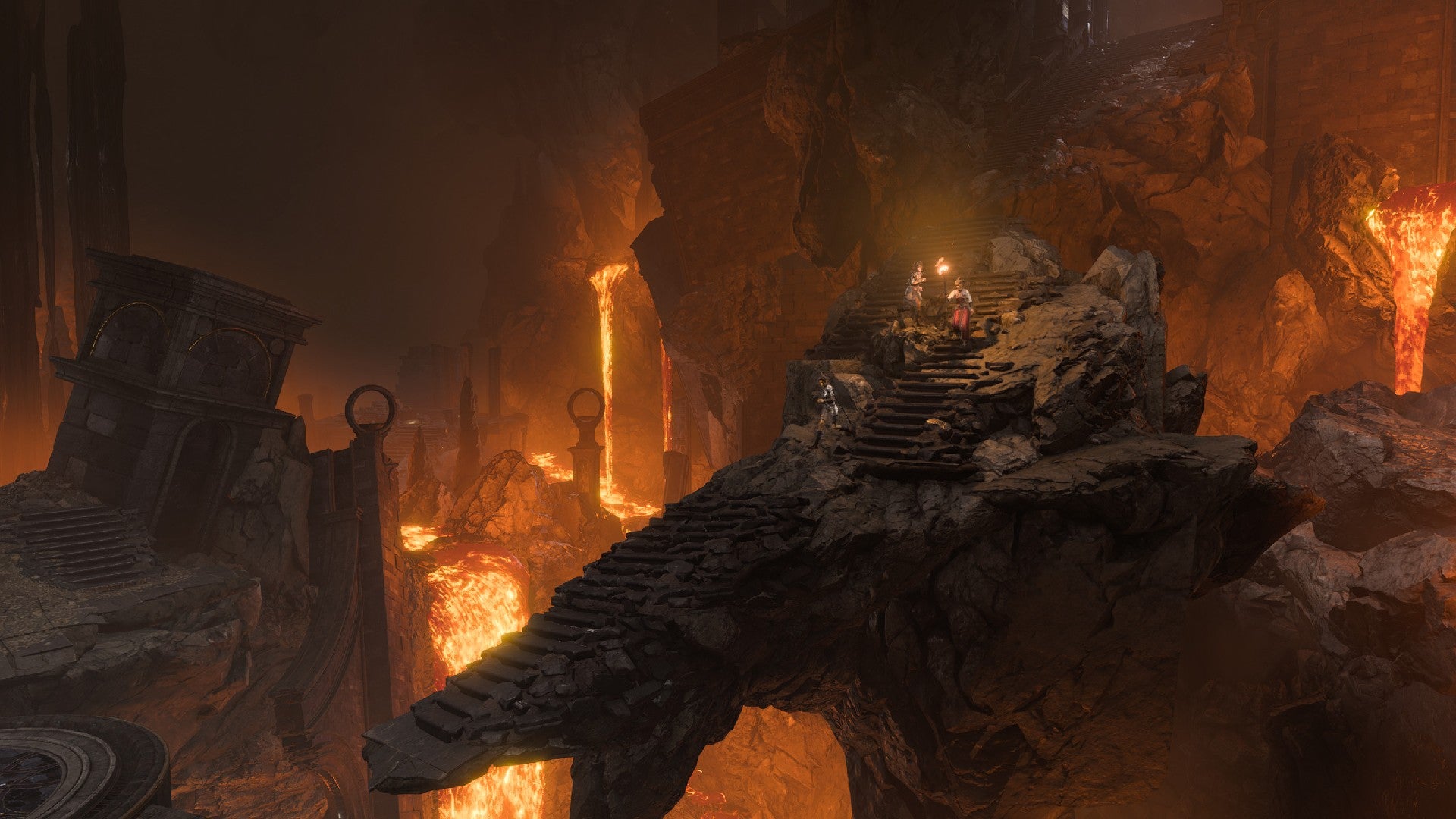Whether you played when it first entered Early Access, or have been eagerly waiting until the full launch, there’s lots to learn. Luckily, we’ve got all the info you need below, including the expected release window, trailers, available classes and races, setting and story details, the size of this epic RPG, gameplay details and info on various mechanics, and some of our thoughts from the Baldur’s Gate 3 Early Access review. Sheesh, that’s a lot to look at, so let’s roll initiative and dive in. On this page:
Baldur’s Gate 3 expected release date Baldur’s Gate 3 trailer Baldur’s Gate 3 classes and races Baldur’s Gate 3 setting and story Baldur’s Gate 3 gameplay Is Baldur’s Gate 3 multiplayer? How big is Baldur’s Gate 3? Baldur’s Gate 3 Early Access thoughts Baldur’s Gate 3 system requirements
Big fans of D&D (or TTRPGs in general) should go check out our sibling site, Dicebreaker, right now. They’re an incredibly talented bunch, and they offer a wealth of knowledge that should help you understand the wider D&D phenomenon much better. For a history lesson on the hobby, we’d highly recommend reading Liv Kennedy’s piece on D&Ds role in the satanic panic of the 1980s. It’s very good!
Baldur’s Gate 3 expected release date
Baldur’s Gate 3 will fully release in August 2023. Of course, you can enter Early Access by purchasing it on Steam right now. The current Early Access version allows you to play through Act 1 of Baldur’s Gate 3, which lasts roughly 30 hours. There are many classes and races to test, though, so you might find yourself playing for much longer across various saves. If you want to experience the whole story in one go, we’d recommend waiting until the full release arrives in August.
Baldur’s Gate 3 trailer
Below, you can find the latest Baldur’s Gate 3 trailer, which debuted during The Game Awards 2022. It features plenty of dungeons and dragons, as you’d probably expect, and acts as a lovely snippet of everything that’s arrived throughout Early Access, while giving lots to look forward to. Oh, and there’s a familiar face at the end for Baldur’s Gate veterans, voiced by Critical Role’s Matthew Mercer. Below, you can find the initial Baldur’s Gate 3 cinematic trailer released during E3 2019, followed by footage of Larian’s worldwide reveal of the game on the 27th February 2020.
Baldur’s Gate 3 classes and races
Baldur’s Gate 3 adapts the popular D&D 5E ruleset, and boasts that you’ll be able to play as any class in the core rulebook. For the non-D&D nerds, that’s almost all of the classes, as there have only been two new additions since 5E released (the Artificer and Blood Hunter, neither of which will feature in Baldur’s Gate 3). Below, you’ll find a full list of every class that’s currently available in Baldur’s Gate 3: One last class, the Monk, is yet to arrive. However, Larian has confirmed that all core classes, including the Monk, will be playable in Baldur’s Gate 3, so expect it to land soon enough. You can currently play as nine races in Baldur’s Gate 3, with notable exceptions being the Dragonborn and Half-Orc. We’ll update this list if they’re added during Early Access or after the full launch in August, although neither has been officially confirmed: Baldur’s Gate 3 features a detailed character creator that you can use to customise the appearance of your protagonist, and select their race, sub-race, class, background, and more. However, you can also forego the customisation route entirely, opting instead to use one of five pre-made origin characters in Early Access. The current origin characters are listed below: More origin stories will be available in the full release. Any origin characters that remain unpicked upon starting the game will become companions that you can recruit to your party.
Baldur’s Gate 3 setting and story
Baldur’s Gate 3 takes place in 1494 DR (Dalereckoning - a system used to count years, similar to AD in our calendar). That places it 125 years after the events of Baldur’s Gate 1 and 2, so it’s set long after the intial games in the series. While that should make it easier to approach for those who didn’t play the original games over two decades ago, Larian have confirmed that there will be connections to both. According to Larian CEO Swen Vincke “There are returning characters and what happened in BG 1/2/[Throne of Bhaal] leads to what happens in BG3. You won’t necessarily see that at the start of the adventure, but you will quickly understand once you get further into the game.” After the prologue, Baldur’s Gate 3 picks up on the road between the cities of Baldur’s Gate and Elturel. That places it in the quintessential Forgotten Realms D&D setting, along the Sword Coast. We can assume that we will eventually reach the titular city of Baldur’s Gate, although it does not yet feature in the Early Access version of Baldur’s Gate 3. Those who enjoy the tabletop side of D&D can dive into the current setting with a prequel adventure named Baldur’s Gate: Descent into Avernus. Avernus is set in 1493, just one year before Baldur’s Gate 3 picks up. As a published D&D module, you’ll need at least a couple of people, with one willing to DM, if you want the full experience. It sounds like it’s well worth the effort, though - Dicebreaker rank it third on their list of the 10 best D&D 5E adventure modules.
Baldur’s Gate 3 gameplay
Baldur’s Gate 3 is a vast RPG with turn-based combat. That’s a pithy sentence that’s trying to describe something huge, and Baldur’s Gate 3 is certainly that. It borrows from the D&D 5E rulebook, which is over 200 pages of numbers, stats, and oh-so-many-rules, so grand RPG is the simplest way to describe something that is not simple. Fortunately, you can check out videos of gameplay on the interwebs to see it for yourself. Outside of combat, you’re no longer restricted to turn-based actions. You can roam freely, controlling a character from either overhead or third-person perspective by pointing-and-clicking with the mouse. As you might in pen-and-paper D&D, you can speak to a staggering amount of NPCs, take quests, slay beasts, pick pockets, and just about anything else you want to do in this responsive world. When talking to people throughout the world, you make dialogue choices that are framed in past-tense, as if narrating your actions to a Dungeon Master. This is, after all, Dungeons and Dragons. Adapting the 5E ruleset doesn’t mean you need to learn the latest D&D edition to understand Baldur’s Gate 3, thankfully. Yes, put that weighty Player’s Handbook down, you’re going to break a toe. Baldur’s Gate 3 splits skill tests into active and passive checks. The former make you roll dice on screen, chucking a D20 around for important actions in dialogue or combat. For example, you’ll see a big dice tumble across your monitor to check if you successfully lie to someone during a conversation. Passive checks occur when the game checks something without a visible roll. For example, if there is a secret door nearby, a passive perception check will occur to see if you notice. If you do, cool, secret door! If not, you go on as if nothing happened. The outcome of passive checks depends on your overall stats, rather than the luck of the dice. The staggering amount of rules, rolls, and checks in D&D 5E can get overwhelming, but Baldur’s Gate 3 aims to streamline the process. It does a lot of the math-ing for you, sorting finicky calculations and deeming how things will react while you sit back, relax, and make cool shit happen. It’ll undoubtedly be a lot to wrap your head around for those who’ve never heard of a TTRPG, but it should be far easier to play than its pen-and-paper inspiration.
Is Baldur’s Gate 3 multiplayer?
Baldur’s Gate 3 is multiplayer with up to four players in the same party. Don’t expect to always hang out together, though, as Baldur’s Gate 3 lets you split the party. You can each follow your own quests, or work together to overwhelm your enemies as a group. Of course, you can also split up while working towards the same objective. Have a couple of players distract some guards, while another sneaks in to grab some loot. Oh, and someone else is probably setting stuff on fire in the corner. That’s classic D&D, right there.
How big is Baldur’s Gate 3?
It’s a hard question to answer, as much of Baldur’s Gate 3 is unknown past the ending of Act 1 and the Early Access storyline. Act 1 will last for roughly 20-30 hours, depending on how much you explore while playing. However, that’s just with one character. If you want to try every class, that’s already hundreds of hours.
Baldur’s Gate 3 Early Access thoughts
Since Baldur’s Gate 3 is already playable, we have an Early Access review up from the original launch. Ex vid bud Matthew Castle (RPS in peace) said that “the first act of Larian’s revival of the legendary RPG series has a lot to recommend it. Enough, in fact, that you may want to wait for the full thing to experience it in one go”. As Matthew puts it, “the meat of your mulling won’t be answered for some time”. So, if you’re eager to see the story in full, without a months-long wait for the consequences of your actions, then we’d suggest waiting a little longer. Come August, you’ll be able to experience the entire story, and it’s sure to be more satisfying when you aren’t cut off at the end of Act 1.
Baldur’s Gate 3 system requirements
Below, you’ll find both the minimum and recommended Baldur’s Gate 3 system requirements:
Baldur’s Gate 3 minimum system requirements:
OS: Windows 7 Processor: Intel i5-4690/AMD FX 4350 Memory: 8GB RAM Graphics: Nvidia GTX 780/AMD Radeon R9 280X DirectX: Version 11 Storage: 150 GB available space
Baldur’s Gate 3 recommended system requirements:
OS: Windows 10 Processor: Intel i7 4770k/AMD Ryzen 5 1500X Memory: 16GB RAM Graphics: Nvidia GTX 1060/AMD RX580 DirectX: Version 11 Storage: 150 GB available space
That’s pretty much everything we know so far on Baldur’s Gate 3, but be sure to check back here for all the latest deets on this tremendously promising RPG! Disclosure: Rock Paper Shotgun’s former Deputy Editor, Adam Smith, is now a senior writer for Larian and currently working on Baldur’s Gate 3.


